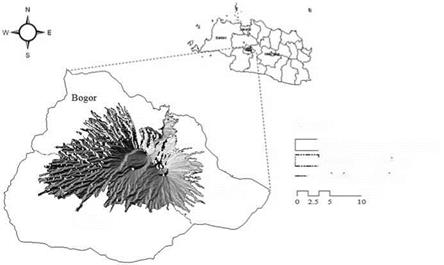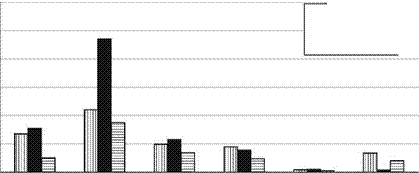16.2.1 Study Areas
Gunung Gede Pangrango Biosphere Reserve, better known as GGPNP, is a protected area that functions as a core zone of Cibodas Biosphere Reserve (Wiratno et al. 2003). It is one of the seven Biosphere Reserves in Indonesia, recognized by
 Legend
Legend
I Biosphere reserve boundaries j GGPNP boundanes
— District boundanes
Sukabumi
Fig. 16.1 Location of Gunung Gede Pangrango National Park (GGPNP) Biosphere Reserve
UNESCO in 1977, and one of the five oldest national parks in Indonesia, established in 1980. The GGPNP is administratively located in three districts of Cianjur, Sukabumi, and Bogor in the Province of West Java (Fig. 16.1). Sub-montane, montane, and sub-alpine forests are represented, situated between an altitude of 1,000 m and 3,019 m. The park is dominated by two volcanoes: Mount Gede and Mount Pangrango. The current total area of the GGPNP is 22,851 ha.
This park is very important as it is among the few remaining montane habitats and ecosystems of Java. More than 1,000 species of higher/flowering plants have been recorded, composing about 120 plant families. The park includes more than 200 species of orchids, about one third of all the orchid species found in Java. The vegetation in GGPNP is divided into three vegetation zones based on altitude: the Sub Montane Zone (1,000-15,000 m above sea level) dominated by Schima walichii, Altingia axalsa, Castanopsis argentea, and Quercus spp.; the Montane Zone (1,500-2,400 m above sea level) with Podocarpus imbricatus, Quercus spp., Podocarpus neriifolius, Castanopsis spp., and Altingi exelsa, and the seedlings in this area include Strobilanthes cermuis, Begonia spp., and Melastoma spp.; and the Sub Alpine Zone (>2,400 m above sea level) dominated by Isachne pangrangensis, Anaphalis javanica, Vacinium varingifolium, Leptospernium flanescens, Symplocos javanica, and Eurya acuminata.
The birds species excite particular interest, attracting ornithologists from all over the world; this is not surprising considering that more than half of Java’s bird fauna can be seen here, including most of the “Javan endemic birds.” Threatened or endangered mammals, which include the leopard, the Javan gibbon, and the Javanese leaf monkeys, are preserved in this area. This area is also the habitat of 245 species of Javanese birds and many species of fauna such as Panthera tigris
Total population
 District 2003 2009 Area (ha)
District 2003 2009 Area (ha)
Cianjur 60,741 150,556 187,068.00
Sukabumi 91,780 173,661 777,421.71
Bogor 59,852 160,000 4,464.63
Total__________ 212,373______ 484,217______ 968,954.33
Resource: GGPNP Biosphere Reserve Management Board
sondaica, Bos javanicus, and Hylobates moloch. From the aspect of biodiversity, GGPNP is highly significant; therefore, in 1977 the UNESCO recognized GGPNP as a biosphere reserve.
For decades the GGPNP have been important sources for livelihood of local people and sometimes have contributed to national economic development. This park has contributed significantly to the reduction of poverty and sustainable development (Wiratno et al. 2003). The park carries out many functions that are beneficial to community and welfare, which include biodiversity, watershed protection, tourism, forest products, carbon, water, research, and cultural values. The way these functions are transformed into benefits for people, including the poor rural inhabitants living around the park, depend heavily on the proper management of the park to translate policy on sustainable land use into actions within the biosphere reserve.
The easy accessibility of the park makes it a popular recreation area. However, its location within West Java makes it all the more susceptible to the pressures of the ever-increasing populations surrounding it. With the three large cities of Jakarta, Bandung, and Bogor located not more than 80 km from this park, the GGPNP Biosphere Reserve is one of Indonesia’s popular resorts for family picnics and camping. Greater efforts are required to prevent local populations and visitor pressures from becoming a threat to ecosystem conservation. This biosphere reserve is divided into three zones according to UNESCO definition: (1) the core zone; (2) the buffer zone; and (3) the transition zone.
Recently, human activities have been increasing because of high population density and economic pressure in the surrounding areas. Local communities use several products from the GGPNP to support their lives, using these products for household purposes. There are 66 villages around the transition zone of the park with 46 villages located close to the forest boundaries. Table 16.1 shows the alteration of total population in the transition zone. There were 212,373 people living in the transition zone in 2003, increasing up to 484,217 people in 2009. The total area is 968,954.33 ha, divided into three districts: Sukabumi, Cianjur, and Bogor. About 66 % of local people in transition zone have low education and 12 % of them have better education (Fig. 16.2). The major ethnic group in this area is Sudanese with agriculture as the main source of livelihood.
Population pressure has forced the transition-zone farmers to engage in the buffer zone. Table 16.2 shows the types of forest disturbances in GGPNP Biosphere Reserve in 2003-2009.
 |
Fig. 16.2 Total population with their education level in surroundings of the GGPNP Biosphere Reserve
|
Table 16.2 Forest disturbances in GGPNP Biosphere Reserve
Resource: The GGPNP (2009) |
Worried by these conditions, the GGPNP Biosphere Reserve Management Board has several social programs to mitigate this interference. The social programs are an implementation of The Law of Republic of Indonesia Number 5/1990 about conservation of living resources and ecosystem. The aims of the social program was to improve the wealth of the local community in the supporting area and to increase environmental awareness. Therefore, through community awareness it is expected that forest disturbances will be reduced.
In 1993-1994, the GGPNP introduced the village economic development program. This program includes the multipurpose tree species seeds system, rabbit and sheep breeding system, and capital for entrepreneur groups system (Siarudin and Mile 2005). In working on the integration of conservation objectives into development of land use planning, since 1994, a multistakeholder partnership as a consortium of 14 institutions (which consists of NGOs, private sectors, local community, and government bodies) was established to encourage cooperation and to develop sustainable land use surrounding the park. The consortium is known as GEDEPAHALA, which stands for Gede-Pangrango-Halimun-Salak, the name of the mountains that connect the national park. Halimun and Salak mountains are now managed as a national park as well. Accordingly, activities in the
park are carried out collaboratively between the park authority, international organizations, local NGOs in the local community, local government, and the private sector. Multi-stakeholder partnerships will bring a big impact on conservation. The private sector’s full support and involvement are very much needed to support sustainable land use. On December 2007, the GEDEPAHALA then launched one of its programs named Adoption Trees, a program that aims to implement conservation and management to support restoration of degraded lands in accordance with sustainable land use by local people and supported by wider communities.
In 2006, the Ministry of Forestry launched another social program, “Conservation Village Model”: CVM. The aim of this program is to empower local community living in and outside the national park. CVM concepts were tried to develop local economics through open access of resources of income by develop the potential of nature (such as developing ecotourism) and to help the local community by giving livestock (such as goats, catfish, and hardwood seeds), home industry, environmental service, and natural tourism (such as home stay, interpreters, and mini-hydro electric power). The GGPNP Biosphere Reserve started to implement this program in 2007 through the Design Engineering of Conservation Village Model. During the first period in the year 2007, they selected four example villages: Sukatani, Kebonpeteuy, Lemahduhur, and Sukamaju.


